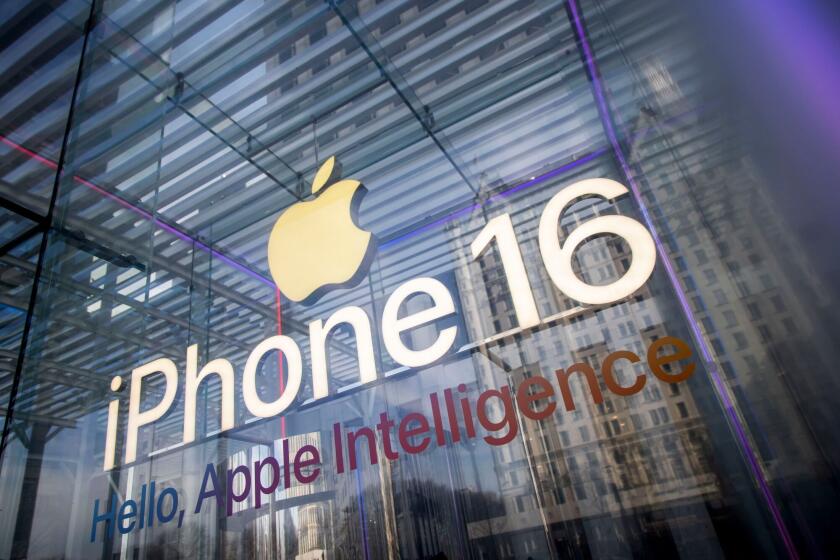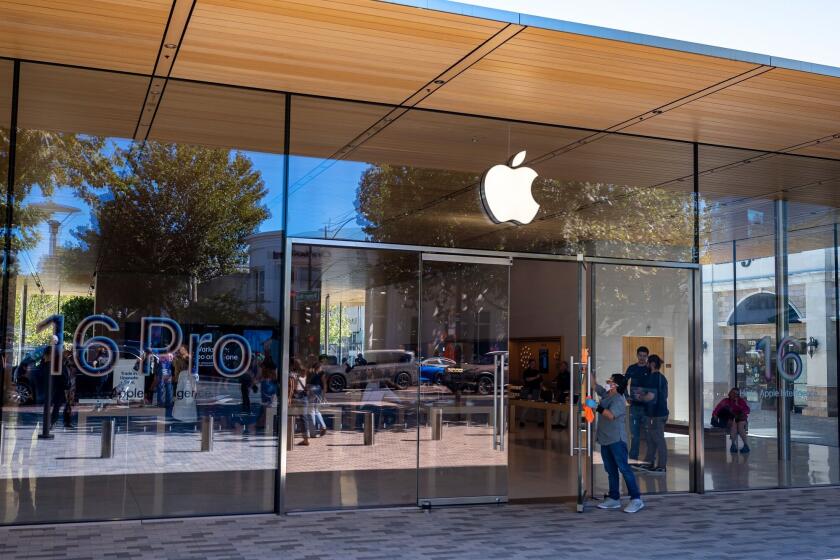Apple in PR mode for Pro X
- Share via
The backlash over Apple’s redesign of Final Cut Pro video editing software two years ago was so severe that even slashing the price by $700, to $299, caused an uproar.
Video editors jeered that Apple had abandoned loyal professional users to create a cheap product aimed at consumers. References to “Apple’s lemon” and “debacle” became common refrains in blog posts and industry trades scrutinizing the fallout.
“It may sing and dance and create unicorns, but you’ve got a well-deserved PR mess on your hands,” read one comment about Final Cut Pro X in Apple’s App Store. “Shame on you.”
Now, after updating the software seven times since its release in 2011, Apple is launching a campaign Thursday aimed at winning back skeptical professional users.
That campaign, timed to coincide with the National Assn. of Broadcasters convention that starts April 6 in Las Vegas, will feature users like Julian Liurette, who followed the firestorm from his video editing desk in Toronto at the Globe and Mail newspaper.
After waiting a year as Apple gradually released updates, Liurette finally gave it a try and was surprised. So Liurette began moving the newspaper’s video operations from the old version to Final Cut Pro X.
“It’s better on all fronts,” Liurette said. “Its interface is 100 times more interesting. And it’s much, much faster.”
The importance of Final Cut Pro to Apple is as much psychic and emotional as financial and strategic. Apple doesn’t disclose revenue that Final Cut Pro generates, but it’s not material enough to make or break the earnings of a company with revenue of $156 billion last year, and where profits are far more dependent on sales of iPhones and iPads.
Still, it’s a product that targets the most creative of people, the ones who occupy the intersection of art and technology that Steve Jobs always believed represented the core of Apple’s identity. Nurturing that reputation remains a point of both pride and passion at the company he left behind.
Indeed, the release of the first version of Final Cut Pro in 1999 at a price of $999 was originally an attempt to cater to creative professionals while bringing the ability to make high-quality video to the average user. The dominant company in the pro video editing space at the time, Avid Technology Inc. of Burlington, Mass., sold a complex hardware and software system that could cost many thousands of dollars.
At first, the pros didn’t buy Apple’s sales pitch. But within a few years, Final Cut was gaining momentum with smaller independent producers. One big breakthrough came in 2003 when Academy Award-winning editor Walter Murch revealed that he had edited “Cold Mountain” on Final Cut Pro. Apple featured a video of him discussing the product on its website at the time.
By 2007, according to one marketing study, Final Cut Pro had grabbed 49% of the U.S. pro video editing market, compared with just 22% for Avid. But Avid still dominated among the elite. According to a 2008 survey conducted by American Cinema Editors, whose 350 members constitute primarily the most senior film editors, about 21% used Final Cut Pro with the rest primarily on Avid.
Yet video technologies continued to change as the cost of shooting and storing video plunged, and broadband became widespread. Many editing programs were still based around the work flows designed for physical film. Apple decided it was time to rethink the editing process from the ground up, for a world in which creators were amassing huge volumes of footage and storing it in digital files, according to Richard Townhill, Apple’s senior director of applications marketing.
So in April 2011, Apple unveiled Final Cut Pro X at an event held near the NAB convention in Las Vegas. Just as dramatic was the price: It would now cost only $299, a steep cut from the $999 price tag for Final Cut Pro 7.
The backlash was swift and fierce.
Critics were angry that many of their favorite features from Pro 7, such as the ability to edit together shots from multiple cameras, were missing. The projects they had created in Pro 7 were not compatible with Pro X, though Apple agreed to continue supporting the old version. It was harder to work in collaboration with multiple editors. And many believed that at such a cheap price, the new version surely couldn’t be powerful enough for professionals.
“I quickly looked at this and said, ‘I can’t use this,’ ” said Murch in November 2011. “I had to wonder, what is the ‘pro’ part of this?”
Apple’s competitors pounced. Both Avid and Adobe, which sells an editing product called Premiere, launched marketing campaigns to persuade users to switch. Both offered discounts and incentives to disaffected Apple customers.
Adobe and Avid reps say they’ve made big gains in the last two years, while Townhill of Apple says Pro X has become the most downloaded version of the software ever. All three competitors agree that it’s hard to find independent, third-party market research to verify any claims.
Regardless of who’s on top, some hard feelings remain.
“Personally, I’m still suspicious of Apple,” said Harry Miller, head of the American Cinema Editors’ technology committee. “I don’t think they have my interests at heart. And I don’t want to invest money in any of their hardware or software when they might drop features in new versions.”
Starting Thursday, the company plans to begin posting three stories on its website, including Liurette’s, aimed at changing the minds of folks like Miller by demonstrating how sophisticated users have embraced Final Cut Pro X. The stories will also feature Tsui Hark, one of the biggest names in Hong Kong cinema, and TV Azteca, which produces thousands of telenovela episodes every year.
“For a TV editor, speed is everything,” says Azteca Telenovela editor Jonathan Contreras in one Web story. “And Final Cut Pro X is faster than any other editing application I’ve used.”
Even many of those reluctant to upgrade give Apple credit for a number of initiatives, including offering detailed road maps of which features it planned to add and when. Apple also allows users to download Pro X and try it free for 30 days -- the only software the company makes available on a trial basis.
Miller of ACE noted his group might have another incentive to give Pro X a look. Some are growing nervous about just how long Apple will support the old version of Final Cut. And they’re worried that Avid, which has not been profitable for several years, has an uncertain future.
“We are in a precarious business,” Miller said. “We’re afraid some of these big players are going to go away. As editors, at the end of the day, we’ll support whoever has the best platform out there.”
--




